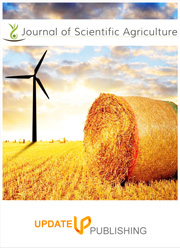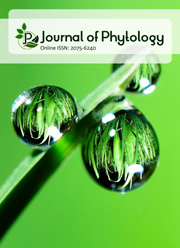Raiding of agricultural crops and forests by wild boar (Sus scrofa L.) and its mitigation tricks
DOI:
https://doi.org/10.25081/jsa.2019.v3.5295Keywords:
Wildlife damage management, Vertebrate pest, Wild pig, Agricultural crops, Frosts, Damage mitigationAbstract
Wild boar (Sus scrofa L.), is the utmost communal native species of wildlife to bring about plants injury. In this article, it is proved that wild boar is an important factor and a particular concern to the agricultural industry regarding crops and frosts damage along with its alleviating tactics. Wild boar may destroy to agricultural crops by crushing or eating of plants. Likewise, these may harm to crops while wallowing and rooting which injury to plant roots, and form holes and grooves that harm farm equipment and endanger operations. Wild boar injury is more in fields that are in neighboring vicinity of forests ranges. Wild boars harshly influence trees and timber resources in many ways like disturbance of planted seedlings, girdling and rubbing of matured trees, chewing and rooting of sideway roots of fully-fledged trees, and tusking or scent marking with the tusk glands that injuries to tree bark. Mitigation strategies for wild boar losses comprise creation of education and awareness among persons, co-operative securing of matured crops and use of local protective methods. Wild boar can be managed through small-scale exclusion, trapping and shooting tactics. Shooting is a popular method of controlling wild boar populations and in this way pressure from hunting will let the pest to move away from where they are hunted, or at a minimum, will restrict their movements. It has been found that using of dogs is the most effective for locating of individuals or smaller groups of wild boars. In some cases, a female boar is trapped, spayed fitted with a radio collar and then released in field. Since female boars live in groups, the spayed female will lead wildlife managers to local boar populations, which can assist in population control efforts. While recreational hunting is often a preferred method, it is also effective to some extent at controlling of wild boar population growth. Trapping, however, is highly effective at controlling and reducing of boar’s population growth. The study of spatiotemporal variant of boar-inflicted losses and recognition of reasons which boost the risk of harm delivers necessary facts for contributing to develop a further effectual strategy for handling of wild boar’s density.
Downloads
References
2. Sarwar, M. Pattern of Damage by Rodent (Rodentia: Muridae) Pests in Wheat in Conjunction with Their Comparative Densities throughout Growth Phase of Crop. International Journal of Scientific Research in Environmental Sciences 2015; 3 (4): 159-166.
3. Sarwar. M. The Rodents (Mammalia: Rodentia) - Gnawing Away on Stored Grains and Options for the Integrated Pest Management in Stores. American Journal of Food Science and Health 2016; 2 (6): 161-168.
4. Ballari, S. A. and Barrios-García, M. N. A review of wild boar Sus scrofa diet and factors affecting food selection in native and introduced ranges. Mammal. Rev 2014; 44: 124-134.
5. Meng, X., Lindsay, D. and Sriranganathan, N. Wild boars as sources for infectious diseases in livestock and humans. Philos. Trans. R. Soc. Lond. B. Biol. Sci 2009; 364: 2697-2707.
6. Colino-Rabanal, V. J., Bosch, J., Munoz, M. J. and Peris, S. J. Influence of new irrigated croplands on wild boar (Sus scrofa) road kills in NW Spain. Anim. Biodivers. Conserv 2012; 35: 247-252.
7. Engeman, R. M., Duffiney, A., Braem, S., Olsen, C., Constantin, B., Small, P., Dunlap, J. and Griffin, J. C. Dramatic and immediate improvements in insular nesting success for threatened sea turtles and shorebirds following predator management. J. Exp. Mar. Biol. Ecol 2010; 395: 147-152.
8. Amici, A., Fioravante, S., Carlo, M. R. and Riccardo, P. Increase in crop damage caused by wild boar (Sus scrofa L.): the “refuge effect”. Agronomy for Sustainable Development 2012; 32 (3): 683-692.
9. Lombardini, M., Lombardini, A. M. and Alberto, F. Factors influencing wild boar damage to agricultural crops in Sardinia (Italy). Current Zoology 2017; 63 (15): 507-514.
10. Chauhan, N. P. S. and Rajpurohit, K. S. Survey of Animal Damage Problem in and around protected areas and managed forests: Phase- I Madhaya Pradesh, Bihar and Orissa - A Report, Wildlife Institute of India, Dehradun. 1993.
11. Groot-Bruinderinck, G. W. T. A., Hazebrook, E. and Van der Voot, H. Diet and condition of wild boar (Sus scrofa scrofa) without supplementary feeding. J. Zool. Soc. London 1994; 233: 631-648.
12. Rao, V. V., Naresh, B., Reddy, V. R., Sudhakar, C., Venkateswarlu, P. and Rao, D. R. Traditional management methods used to minimize wild boar (Sus scrofa) damage in different agricultural crops at Telangana state, India. International Journal of Multidisciplinary Research and Development 2015; 2 (2): 32-36.
13. Baskin, L. and Danell, K. Ecology of ungulates: A handbook of species in eastern Europe and northern and central Asia. Springer-Verlag, Berlin. 2003: 15-37.
14. D’Huart, J. P. Habitat utilization of old world wild pigs. In: Herrero, H., Irizar, I., Laskurain, N. A., García-Serrano, A., & García-González, R. 2005. Fruits and roots: wild boar foods during the cold season in the southwestern Pyrenees. Italian Journal of Zoology 1991; 72: 49-52.
15. Chauhan, N. P. S. Human casualties and agricultural crop raiding by wild pigs and mitigation strategies in India. The 8th European Vertebrate Pest Management Conference, Julius-Kuhn-Archiv 2011; 432: 192-193.
16. Thurfjell, H., Ball, J. P., Ahlen, P.A., Kornacher, P., Dettki, H. and Sjoberg, K. Habitat use and spatial patterns of wild boar Sus scrofa (L.): agricultural fields and edges - European Journal of Wildlife Research 2009; 55: 517-523.
17. Schley, L., Dufrene, M., Krier, A. and Frantz, A. C. Patterns of crop damage by wild boar (Sus scrofa) in Luxembourg over a 10-year period. European Journal of Wildlife Research 2008; 54: 589-599.
18. Guo, W., Cao, G. and Quan, R. C. Population dynamics and space use of wild boar in a tropical forest, Southwest China. Global Ecology and Conservation 2017; 11: 115-124.
19. Gentle, M., Speed, J. and Marshall, D. Consumption of crops by feral pigs (Sus scrofa) in a fragmented agricultural landscape. Australian Mammalogy 2015; 37 (2): 194-200.
20. Hamrick, B., Campbell, T., Higginbotham, B. and Lapidge, S. Managing an Invasion: E?ective Measures To Control Wild Pigs. USDA National Wildlife Research Center - Sta? Publications. 1300. The Wildlife Professional 2011: 41-42.
21. Giuliano, W. M. Wild Hogs in Florida: Ecology and Management. Department of Wildlife Ecology and Conservation, University of Florida/ Institute of Food and Agricultural Sciences, Extension Service. 2016: 9.
22. Zhang, C. and Kovacs, J. M. The application of small unmanned aerial systems for precision agriculture: a review. Precision Agriculture 2012; 13: 693-712.
23. Puig, E., Gonzalez, F., Hamilton, G. and Grundy, P. Assessment of crop insect damage using unmanned aerial systems: A machine learning approach. The 21st International Congress on Modelling and Simulation, Gold Coast, Australia, 29 Nov to 4 Dec 2015. 2015; 1420-1426.
24. Schlageter, A. and Haag-Wackernagel, D. Evaluation of an odor repellent for
protection crops from wild boar damage. Journal of Pest Science 2012; 85: 209-215.
25. Hamrick, B., Smith, M. D., Jaworowski, C. and Strickland, B. A Landowner’s Guide for Wild Pig Management: Practical Methods for Wild Pig Control. Extension Service of Mississippi State University. 2011: 43.
26. Higginbotham, B. Chumming - Feral Hogs. Quality Whitetails magazine (June-July) 2011: 22-29.
27. Bieber, C., and Ruf, T. Population dynamics in wild boar Sus scrofa: ecology, elasticity of growth rate and implications for the management of pulsed resource consumers. Journal of Applied Ecology 2005; 42: 1203-1213.
28. Magnusson, M. Population and management models for the Swedish wild boar (Sus scrofa). Epsilon 2010; 18: 1-26.
29. Kornacher, P. Wild boar Sus scrofa damage reductions through large scale management: Applying hunting and feeding as management tools. Epsilon 2006; 6: 1-25.
30. Abbas, M., Khan, S. H., Khan, R. A. and Shahbaz, M. Efficacy of Different Methods to Control Wild Boars: A Perception of Farmers of the Faislabad Division. Pak. J. Agri. Sci. 2004; 41 (3-4): 144-145.
31. West, B. C., Cooper, A. L. and Armstrong, J. B. Managing wild pigs: A technical guide. Human-Wildlife Interactions Monograph 2009; 1: 1.
32. Thurfjell, H., Spong, G. and Ericsson, G. Effects of hunting on wild boar Sus scrofa behavior. Wildlife Biology 2013; 19 (1): 87-93.
33. Sodeikat, G. and Pohlmeyer, K. Escape movements of family groups of wild boar Sus scrofa influenced by drive hunts in Lower Saxony, Germany. Wildlife Biology 2003; 9: 43-49.
34. Geisser, H. and Reyer, H. U. Efficacy of Hunting, Feeding, and Fencing to Reduce Crop Damage by Wild Boars. The Journal of Wildlife Management 2004; 68 (4): 939-946.



 .
.